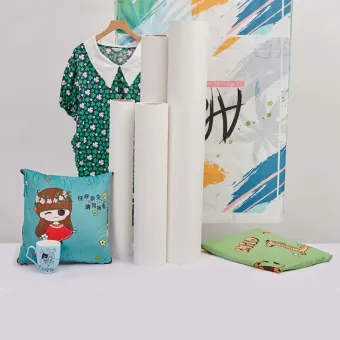Choosing the Correct Sublimation Paper
Feb. 28, 2024
Choosing the Correct Sublimation Paper
Consider the following factors when selecting the appropriate sublimation transfer paper.
Ink Capacity and Limits
An essential consideration is the ink limit, where a higher wet ink limit requires a heavier paper to absorb moisture without issues such as curling and warping.
Ink Pattern
This factor relates to the printing of intricate designs with a mix of heavy and light ink. Lightweight papers may lead to curling and shifting after pressing. To mitigate this, it is recommended to use 110gsm or higher papers that can accommodate both heavy and light inks.
Roll to Roll or Roll to Sheet
Low-gsm papers are preferred for calendar heat presses, but careful consideration is needed when dealing with heavy ink. Balancing the ink limit and capacity is crucial to avoid complications like warping and curling during high-capacity production.
Print Speed
The quality of the paper produced is influenced by the printing speed. Fast printing results in lightweight paper, while slow printing produces thicker paper.
Sublimation Paper and Working Environment Humidity
Low Humidity (Below 45%): Opt for 80gsm paper in low humidity conditions. In environments with humidity under 45%, selecting 80gsm helps prevent paper shrinkage and the hunching-up of the print side. The absorption of ink during the process can lead to this "hunch-up" issue. Papers with higher weights, such as 100g and 120g, are more rigid and can damage the print head when encountering the "hunch-up." The softer nature of 80gsm helps alleviate the hunching-up, thereby protecting the print head from damage.
High Humidity (Above 70%): Choose 110-120gsm paper in high humidity conditions. Excessive humidity makes the paper prone to dampness, causing it to become softer with weakened stiffness. Using low-weight paper in such conditions can hinder smooth printing due to reduced stiffness and hardness. In high humidity, opting for 110-120gsm paper is the optimal choice.
Uses of Sublimation Paper
Apparel Applications: Ideal for Lycra materials, cycling attire, Polyamide fabrics, Swim & Surfwear, 100% polyester (stretch), running gear, and ice hockey wear. Also suitable for sports and functional textiles.
Home Use: Perfect for creating curtains, blinds, cushions, table covers, towel cleaners, and more.
Advertising: Well-suited for producing flags, banners, felts, gaming tables, and various home textiles.
Sublimation paper is designed for sublimation transfer. Images with mirror reversal can be printed on it using inkjet printing, flat printing, screen printing, and gravure printing. The next step involves transferring the image onto the desired media through heating and pressuring, causing the ink on the paper to transform into a gaseous state and merge with the media.
Heat transfer paper is designed for heat transfer processes. Images are printed on it using flat printing or gravure printing, and then, through a combination of heating and pressuring, the image is transferred onto the desired media.
Sublimation paper is specifically used with sublimation ink. Heat transfer paper is used with sublimation ink, pigment ink, solvent ink or others. Media: Sublimation paper can be transferred onto polyester, mouse pad, banner and hard surfaces, such as mugs, ceramic and aluminium plate. But heat transfer paper is usually transferred onto cotton.
Successful dye-sublimation requires the following two-part process:
Printing graphics onto special transfer paper using sublimation inks.
Using heat press to transfer the ink-on-paper to the item to be designed.
Four Types of Heat Presses:
1. Small Format Heat Press:
This device is suitable for sublimating on t-shirts and small items like caps, mugs, plates, and shoes.
2. Calendar Heat Press:
Large-format presses designed for flags, large exterior banners, and other extensive soft-signage applications, including day-to-day soft signage and fabric sublimation. Users can enhance functionality by adding a table attachment to the calendar unit for cutting and sewing apparel pieces.
3. Flatbed Heat Press:
While not as adept at handling rolls and large fabric sizes as a Calendar heat press, flatbed-style heat presses are versatile machines capable of heat transferring onto fabric, as well as aluminum, hardboard, floor mats, and other unique media.
4. 3D Vacuum Heat Press:
A compact desktop machine allowing heat transfer onto materials with curved edges or shapes. This press is suitable for sublimating blanks and pre-treated objects like smartphone covers, mugs, picture frames, sporting goods, buttons, and more.


















